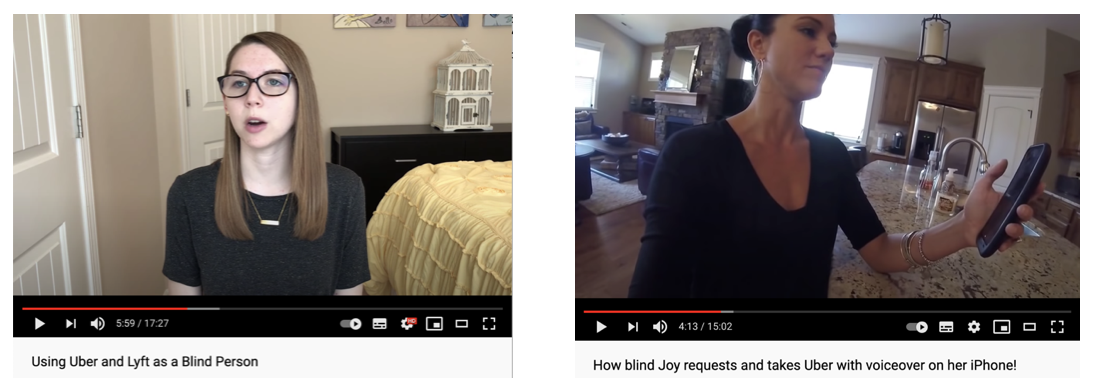Week 3: sketching possible interventions in the ‘en route’ experience and criticism.
Once I reached the stage of developing ideas for this project, I had to put some constraints on it in order to design something specific and to come up with a tangible design. From a tutorial session with one of my tutors I was told that the best way to move forward is to pick one specific target user, as it would facilitate the design process considering the time constraint. This is why from now on instead of focusing on different types of disability, I’ll narrow down my end user group and design for those who are either blind or visually impaired.
However, when designing for this group of people I hope that part of the outcome can be applied to other groups with different disabilities, specially because of the multimodal interaction feature I introduced earlier. Different and efficient ways of combining these modes of interaction can be useful for people with: hearing disability, physical disability, speech impairment, autism or dyslexia.
What I did next was to watch published videos of blind people using car hiring services like Uber and Lyft and listen to their experiences. Personally, I considered these videos as a helpful tool for me to do user research given the circumstances people are facing due the global pandemic: inability to meet people physically and moving between territories. I am aware they’re not directly answering to any of my questions or testing any of my designs, but their insights have given me a deeper understanding of how blind and visually impaired people experience car hiring services. Some interesting aspects people in these videos mention that are related to my project are:
Window wait is the amount of time the car will wait for you once it has arrived to the pick up place. For blind users is important to have at least a 5 minute window.
Physical environment: it’s important where the car picks you up; it’s harder to find a car if you’re in a city than it is to find it on a suburb as there’s less people and cars around.
It’s risky to use the car hiring service for blind people and even riskier for blind women
Visually impaired users might carry their guides dogs everywhere they go, thus is necessary to consider them within the experience.
Coming back to the ‘En route’ user flow I showed in the previous weekly blog, I sketched some ideas that could intervene in the car identification part of the experience. Currently there’s a driver in this car that can help and assist the user during this step, but if we picture an AV picking up a passenger, this step becomes more difficult to overcome for blind or visually impaired users. I speculated some ideas that could help improve this part of the experience:
Identifying the AV: proximity sensors.
With this idea, the AV and the device people use will be connected and the device would make acoustic signals that would indicate how far from the car users are.
Identifying the AV: image recognition + voice assistant.
In this second sketch users will pan their devices around so this can map out the physical environment and identify the AV that’s waiting for them. Once the device identifies the car, this will give assistant to blind users to physically reach the vehicle safely.
When presenting these ideas in front of my classmates and tutors I got some feedback that made me shift my perspective on the way I was seeing things by this point. Two of the things they said that stood up are:
Most of what I’ve done so far is purely driven by technological determinism.
Scholars and designers have reported issues with one of the core design principles I’m following in this project: universal design.
With an aim to broaden my perspective and the way I’ve been carrying this project, I have to be able to understand and process what these critiques could mean. For the first point, about technological determinism, I agree that both options solely focus on the inclusion of new technology to design an experience, which leads me to discard other possible relevant elements of it.
In the two sketches shown previously I could have speculated that instead of an image recognition device or proximity sensors, these tasks could be done by a person. I have to say that my aim wasn’t to introduce technology unnecessarily but to give a high level of autonomy to blind users that want to use car hiring services. A better approach to this would be to actually talk to people who can tell me about the balance between self-reliance and asking for help, instead of me, a non visually impaired person, making up scenarios.
In regards to universal design, after doing more reading about it I can now understand where the issues stem from. Among many, the one that struck me the most was the one stated by Aimi Hamraie: universal Design has become emblematic of a depoliticised orientation toward disability, which invokes human variation as a value but refuses to understand difference as tied to systems of oppression such as racism, sexism, or ableism. My mistake was to absorb universal design without looking into the issues that have been raised by scholars about it.
Bibliography
Vejalla, K., 2020. HCI For People With Disabilities. [online] Medium. Available at: <https://medium.com/@kalyan.vejalla/hci-for-people-with-disabilities-979b6371467b> [Accessed 13 November 2020].
Hamraie, A., 2016. Universal Design and the Problem of “Post-Disability” Ideology. Design and Culture, 8(3), pp.285-309.


